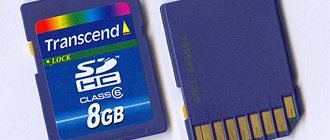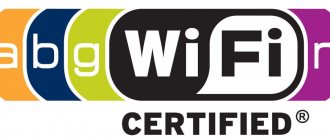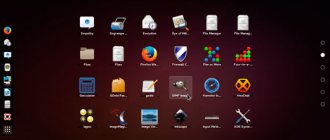Windows 7 is invariably in demand among most users. Why? It has been tested by time and experience, and is considered one of the most convenient and harmonious versions in terms of content. As a rule, not everyone likes the new eighth version; some are simply used to the seventh and do not want to update it. As for the tenth version of the software, it is surrounded by controversy and gossip, because some consider it the best product from Microsoft, while other users persistently find its shortcomings.
Which Windows 7 is faster?
But those who decided to install the “seven” are interested in one question - which Windows 7 is the fastest? There is no clear answer to this question - it all depends on where you download the software from, what set of capabilities you need, and how powerful your computer is.
Let's figure out how different types of Windows 7 differ, which one will be the fastest on a PC, and why you need to know the difference between x64 and x86.
The main differences between Windows 7 packages
OS versions differ in capabilities, but the minimum requirements for computer performance are the same for all packages:
- 32-bit (x86) or 64-bit (x64) processor with a clock speed of 1 gigahertz (GHz) or higher;
- 1 gigabyte (GB) (32-bit) or 2 GB (64-bit) random access memory (RAM);
- 16 gigabytes (GB) (32-bit) or 20 GB (64-bit) hard drive space;
- DirectX 9 graphics device with WDDM driver version 1.0 or higher.
If the components of your computer meet the above requirements, then any Windows 7 will not freeze on it. Remember that these are the minimum requirements for a clean (without third-party programs) system. Compliance with these parameters does not mean that all games and applications written for Windows 7 will start and not freeze.
Now let's look at the availability of certain functions in different versions of the OS. Each subsequent Windows package will contain all the functions of the previous one, while also having new features.
Table: list of features of different packages
| Possibilities | Home Basic | Home Premium | Professional | Ultimate |
| Improved desktop navigation makes it easier to complete common tasks | Yes | Yes | Yes | Yes |
| Quickly and conveniently launch programs and search for frequently used documents | Yes | Yes | Yes | Yes |
| Browse the Internet quickly and securely using Internet Explorer 8 | Yes | Yes | Yes | Yes |
| The ability to choose the place and time for free viewing of your favorite TV programs using Internet television | Yes | Yes | Yes | |
| Ability to create a home network and connect homegroup computers to the printer | Yes | Yes | ||
| Running Windows XP programs in Windows XP mode (separate download) | Yes | Yes | ||
| Domain join feature provides secure connection to corporate networks | Yes | Yes | ||
| Ability to back up data on your home or work network | Yes | Yes | ||
| BitLocker drive encryption protects your computer data from loss and theft | Yes | |||
| Ability to select an interface language from 35 available languages | Yes | |||
| Booting from virtual hard disks (VHDs) | Yes |
Windows 7 Ultimate is also called Windows 7 Ultimate or Windows 7 Enterprise.
What to install - 32-bit or 64-bit Windows?
Here we are considering the situation that we install on a home computer to solve typical household tasks: watching movies, simple work (like typing in MS Word), the Internet, games.
Most sites advise installing the 64-bit version, citing the fact that it “works faster.” Opponents of the 64-bit system motivate their position with a “problem with drivers.” In fact, now there is no such problem. Almost everything is suitable for more or less modern equipment. Yes, you can find a 64-bit driver. In some cases, 32-bit ones are also available - but this risks slowing down the system or even causing it to fall into the “blue screen of death”. So, it is better to install only 64-bit drivers.
In fact, for home computers the performance increase is not as significant as we would like; it is clearly noticeable in mathematical calculations, for example, but in everyday life it is practically unnoticeable; moreover, given that most programs are now 32-bit, it can happen slowing down the work of the pisishnik. This is due to the peculiarity of the execution of 32-bit programs on a 64-bit system. So at the moment it is more advisable to install a 32-bit system (since you can find a 32-bit analogue of a 64-bit program in almost everything. Yes, but the opposite is not always true).
For home computers, there is one exception to the rule - you must install a 64-bit OS if the amount of RAM on your PC is more than 3 gigabytes. 32-bit systems cannot address memory larger than 4 GB, in fact - no more than 3 GB (memory allocation feature). You can enable "advanced" addressing (PAE), but this is a "crutch" that does not always work.
Conclusion: if you have 4 GB or more, install 64-bit Windows 7, in other cases install 32-bit.
Which version to choose
Installing the highest version of the OS on your computer is not the best way; on the contrary, it is strongly not recommended.
Each version is optimized for a specific group of users and their basic needs. For example, the functions present in the “Maximum” package will never be useful to the average user who does not work in large companies and does not understand the detailed settings of the system registry. Installing a more advanced version of the system that exceeds your needs will only overload your computer and confuse you with incomprehensible functions and programs.
To choose the right Windows package, you need to figure out which version of the OS is intended for which group of users.
"Home"
This package is suitable for those who use a minimum number of programs and functions: a browser, explorer, text editor and other similar basic services. If your needs do not exceed these limits, then it is worth purchasing the “Home” version of the operating system.
Windows 7 Home is suitable for users with a weak computer
But there is one caveat: this package is maximally optimized for weak computers. If you have a computer whose characteristics meet the minimum threshold of requirements for the system given above in the article, or its performance is around this minimum level, then opt for Windows 7 Home, as it is as lightweight as possible. This version is well suited for laptops and netbooks. If your computer is more powerful than the minimum level, then it is recommended to consider the following OS package.
"Home Extended"
This version also belongs to the Home package, but has a number of features that are not available in the standard version of Windows 7 Home:
- Searching on the computer and setting up the window interface has been simplified, and support for the Aero function has appeared. This is precisely the main difference between the “Advanced” version and the “Home” version, since along with the Aero technology, many visual effects were added that decorate the appearance of the system, but at the same time load the video card;
- it became possible to create a home group that allows you to quickly exchange files, documents, photos and other elements via the Internet between users in the same group;
- The Media Center program has appeared, through which you can watch TV and record programs running on it.
You should not install Windows 7 Home Premium on laptops, netbooks and weak PCs
So, Windows 7 Home Premium is worth installing if the above capabilities are enough for you, and more sophisticated features such as special data encryption and Windows XP emulation are not needed. Remember that this package is not suitable for users with weak PCs; it is also better not to install it on laptops and netbooks, since the video card may begin to heat up more due to the load and this will damage the device.
This version is good for games. It already has all the necessary functions and is designed for a more powerful computer that can handle some games, but at the same time it is not yet overloaded with additional settings presented in the “Professional” and “Maximum” versions.
"Professional"
The main differences between the “Professional” version of the OS and the home packages:
- built-in Windows XP emulator, which allows you to use programs designed for the previous version of the operating system. That is, you don’t have to install the XP emulator manually or look for programs rewritten for Windows 7;
- automatic and advanced backup, allowing you to restore or roll back the system at any time. This feature is very useful, since you never know at what point Windows will refuse to boot, will start to glitch or slow down. The possibility of such a copy will allow you to use a backup copy to restore the system;
- increased level of data encryption. Useful for users working with important documents and reports;
- local group policy editor, which allows you to configure in detail the processes and functions that occur in the system and are performed by it. It can be used by users who have knowledge in the field of system configuration, although currently on the Internet you can find detailed instructions for beginners that allow you to work with the Group Policy Editor without special knowledge;
- Remote Desktop Connection support. Using this program, you can remotely control your or someone else's computer by connecting to it via the Internet using an IP and password. A very convenient function for those who want to configure the computers of other users without leaving their own, or work with their second computer located in a remote location;
- a simplified way to connect to local networks of a company or any other group of people.
Windows 7 Professional is designed for users who work professionally with Windows
So, this package is suitable for users who manually change Windows settings and work with old programs and important files, and automatic backup will help not lose important data in the event of a system failure.
Starter and Home Premium
These versions have the smallest number of functions, but are the fastest in performance. Features disabled: working with DVDs, Aero function, no note functions and the like.
The weakest versions are well suited for office work; they can ensure reliable and fast work for employees.
Work via the network is limited, only minimal data exchange is available, support for multiple monitors is not available, and the ability to change the main screen saver is disabled. Cost from 1,500 to 3,000 rubles.
What to do if ServerPack is not displayed and how to install it
ServerPack (“Update Pack”) may not be displayed in the system information if it is not installed on the computer. In order for information about an update package to appear in the system information block, you must install this package.
For Windows 7, there is only one package with code 1 - ServerPack 1. You can download it from the official Microsoft website. The package includes a set of updates for stable operation of the system and its optimization. To install it, open the downloaded file and run the program from its current location. Wait for the process to complete and restart your computer.
ServerPack 1 includes a set of updates for stable system operation and optimization
How does one assembly differ from another?
In the information block about the system you can find the line “Build”.
A Windows build is a modified operating system installation package. It can be either official, created by Microsoft, or unofficial, collected by third-party developers. Unofficial builds, as a rule, have their own set of additional functions and preset settings, disabled or added features.
There are people who take standard Windows and edit its settings, adding or disabling certain features. Then they post the installation file with their creation on some sites, and users have the opportunity to download this file and use it to install Windows, but not a clean system, but with the changes that the author of the assembly made there.
Which Windows 7 is better - Ultimate or Professional?
Any of the modern operating systems has different versions, also known as editions, which differ from each other in price and certain set of functions. The domestic consumer, using all available pirated resources, always strives to install the most sophisticated operating system, and this article is intended to answer the question of which version of the “seven” is the most advanced.
It is worth warning that these are just sophisticated versions - that is, you will not even notice most of their advantages, since many functions will not be useful to an ordinary user. There is an urgent need to install one of the named versions only when you really need the tools available only in them.
What's good about the Professional Edition?
Essentially, this is the same Home Extended, but some functions have been added that are not found in its “younger sister”. Firstly, there are tools for creating a network with an expanded domain structure - although you are unlikely to need this unless you provide communication or hosting services. There is also an option for backing up to an external drive or to a network, but this is also difficult to implement - first try to find an external drive of sufficient capacity, and don’t even think about buying enough space on the network - it’s too expensive. In addition, there is also the ability to encrypt data and a WindowsXP emulation mode - the latter is really of interest if you need to run old programs that the “seven” may not open.
What's good about the Maximum edition?
It’s not for nothing that it’s called that – it’s this edition that contains the maximum capabilities among all versions of the “seven”, for example, everything that is in the Professional version. In addition, there is an opportunity to protect data much more reliably, not only on this computer, but also on the network. In general, this publication is focused more on corporate work - there is a whole set of options aimed at creating and maintaining a specific closed network with the possibility of authorization for partial access.
What to choose for your home
As you probably already understood, you, in general, do not need either one or the other for your home - it’s easier to take the Home Extended. However, if you are still chasing the maximum, take the Maximum.
What do the letters K, N, KN mean in the version name?
When searching for the desired build, you may come across names such as Windows 7 Home N. Similar names with an additional letter indicate that this version of Windows is developed for certain countries and does not have built-in Windows Media programs.
The letters K, N, KN in the series name mean that the Windows version does not have built-in Windows Media programs
By installing an assembly with a letter in the name, you refuse to use all programs related to Windows Media. Many users don’t use them anyway, installing more convenient programs for watching movies and listening to music. But the built-in programs from Microsoft also do no harm; if desired, they can be removed after installing the system.
Special assemblies without these programs were created for countries where pre-installed software is prohibited, since it deprives a person of independent choice of software.
General information
We provide you with a list that describes various Windows 7 distributions with a brief description and comparative analysis.
- Windows Starter is the simplest version of the OS and has the lowest price. The initial version has a large number of limitations:
- Supports 32-bit processor only;
- The maximum limit on physical memory is 2 Gigabytes;
- It is not possible to create a network group, change the desktop background, or create a domain connection;
- There is no support for translucent display of windows - Aero.
- Windows Home Basic - This version is slightly more expensive than the previous version. The maximum RAM limit has been increased to 8 GB (4 GB for the 32-bit version of the OS).
- Windows Home Premium (Home Extended) is the most popular and sought-after Windows 7 distribution. It is the optimal and balanced option for the average user. Support for the Multitouch function has been implemented. Ideal price-quality ratio.
- Windows Professional (Professional) - equipped with an almost complete set of functions and capabilities. There is no maximum limit for RAM memory. Supports unlimited number of CPU cores. EFS encryption is installed.
- Windows Ultimate (Maximum) is the most expensive version of Windows 7, which is available to users in retail sales. All the built-in functionality of the operating system is available in it.
- Windows Enterprise (Corporate) is a specialized distribution for large organizations. The average user does not need this version.
The two distributions described at the end of the list will not be considered in this comparative analysis.











